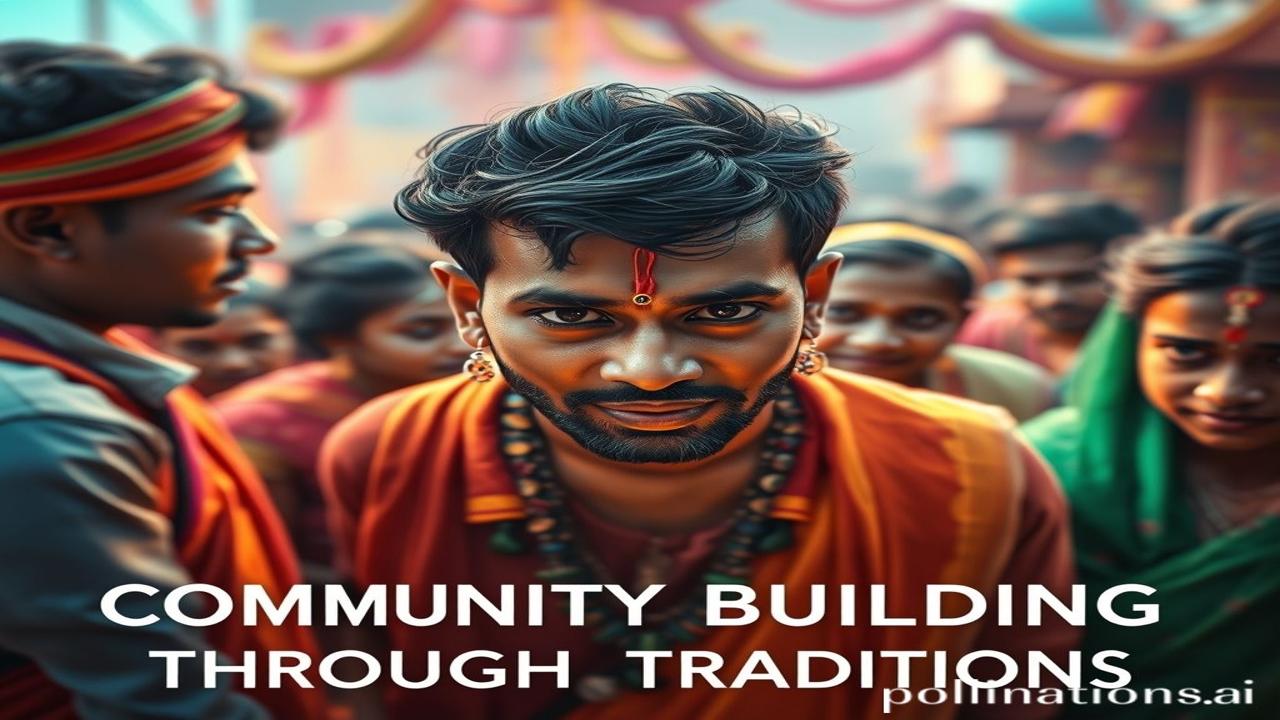Kabhi Socha Hai, Rangon Mein Lipti Ekta Kaisi Hoti Hai? (Ever Wondered, What’s Unity Wrapped in Colors Like?)
Waqt ki dhool mein, kuch lamhe aise chhup jaate hain, jo humari rooh ko aaj bhi chhoo jaate hain. Picture this: The air thick with the scent of marigolds and burning incense, the rhythmic beat of dhols echoing through narrow lanes, and the vibrant hues of sarees swirling like a kaleidoscope. These aren’t just random memories; they are the threads that weave the rich tapestry of Indian community life – the festivals. Kya kabhi socha hai, yeh rangon mein lipti ekta kaisi hoti hai? Let’s explore!
Utsav: The Heartbeat of Community – A Historical Journey
Festivals in India aren’t just holidays; they are community incubators, carefully preserved over millennia. They are the living, breathing testament to “Bharatiyata” (Indianness). Think about it: from the ancient Vedic fire rituals, meant to appease the gods and ensure a bountiful harvest, to the elaborate temple festivals showcasing the skills of artisans and the devotion of the masses, these celebrations were, and are, central to our identity.
Kya hai yeh festival tradition? It’s a collection of practices, beliefs, and artistic expressions, passed down through generations, all culminating in a collective celebration.
When and where did it all start? It’s difficult to pinpoint a precise date, but archaeological evidence suggests that even the Indus Valley Civilization had communal gatherings and rituals. However, the structured festival traditions as we know them really took root during the Vedic and post-Vedic periods (around 1500 BCE onwards) across the Indian subcontinent.
Why is it important? Because it reinforces social bonds, celebrates cultural heritage, and provides a shared experience that strengthens community feeling! Festivals were a time when social hierarchies were momentarily blurred, and everyone – from the king to the common farmer – participated in the joy and festivities. They acted as a glue, holding society together.
Zameeni Sach: The People, The Lives, The Legends
Imagine being a potter in the ancient city of Madurai, just days before the Chithirai Festival. Ma Rukmini ne aaj naye kapde pehne, kyunki mandir mein utsav tha. Your hands, rough with clay, work tirelessly, shaping hundreds of diyas (oil lamps) that will illuminate the Meenakshi Amman Temple. Your children help you paint them with vibrant colors. This isn’t just work; it’s a contribution to the community, a sacred offering.
The air hums with anticipation. The local dancers rehearse their steps, the musicians tune their instruments, and the farmers bring their harvest offerings to the temple. Every individual, every profession, is woven into the fabric of the festival. The king, with his elaborate procession, reinforces his role as the protector of the Dharma, while the saint offers his blessings, reminding everyone of the spiritual core of the celebration.
Farmers would pray for rain and good harvests. Warriors would demonstrate their martial prowess through games and displays. Even the anxieties and fears of the community found expression in ritualistic performances meant to ward off evil. It’s a complete immersion into a shared reality.
Dharohar Aur Pehchaan: Echoes of the Past, Vibrance of the Present
Today, even with the onslaught of globalization and rapid urbanization, the spirit of these festivals continues to thrive. From Durga Puja in Bengal to Diwali across the country, from Pongal in Tamil Nadu to Bihu in Assam, these celebrations remind us of our shared heritage. We see the presence of these traditions in the intricate rangoli designs, the devotional songs, the traditional dances, and the mouth-watering food that are synonymous with each festival.
Diwali lights up not just our homes but also our collective spirit. Holi splashes colors of joy, erasing social barriers. These are not just isolated events, but moments that connect us to our roots and strengthen our sense of “Bharatiyata.” They affirm our identity in a rapidly changing world. The “शक्ति” (Shakti) of community finds its purest expression during these times.
Fun Fact: Kya Aap Jante Hai? (Did You Know?)
Log samajhte hain ki festivals sirf mazaa karne ke liye hote hain, lekin asli sach yeh hai ki they were often intricately linked to agricultural cycles, astronomical events, and historical narratives. Many festivals were designed to celebrate the harvest, mark the solstices, or commemorate important battles or the lives of revered figures. It’s more than just revelry; it’s a sophisticated cultural calendar.
Another interesting fact: Some ancient temple festivals even had designated ‘jokers’ or jesters whose role was to satirize social norms and offer comic relief, reminding everyone not to take themselves too seriously. Think about it – a reminder that even amidst profound tradition, humor had its place.
Drishya Aur Bhavnayen: A Sensory Symphony
Imagine the air thick with the aroma of freshly fried sweets during Diwali. The walls of ancient temples, cool and smooth to the touch, adorned with intricate carvings telling stories of gods and goddesses. The sound of conch shells echoing through the valley during a morning puja. The feel of the warm earth beneath your feet during a village fair.
These sensory experiences are integral to the festival experience. They connect us to the physical world around us and deepen our emotional connection to the community. The colors, the sounds, the smells, the textures – they all contribute to the magic of the moment.
Antim Vichar: Ekta Mein Shakti Hai (Unity is Strength)
Festivals are more than just celebrations; they are the heartbeat of our community. They are reminders of our shared heritage, our collective identity, and the strength that lies in unity.
“Sa no bandhurjanita sa vidhata dhaamani veda bhuvanaani vishva”
(May He who is our kinsman, our creator, and the source of all knowledge, protect and guide us through the universe.)
Let the vibrant colors of our festivals continue to paint a brighter future, one where community and tradition thrive together.
